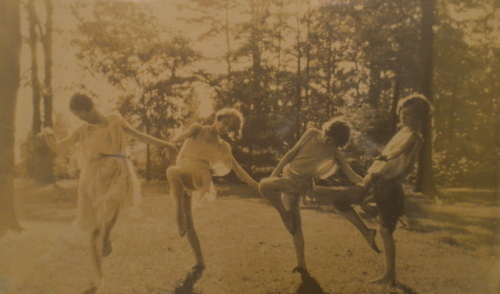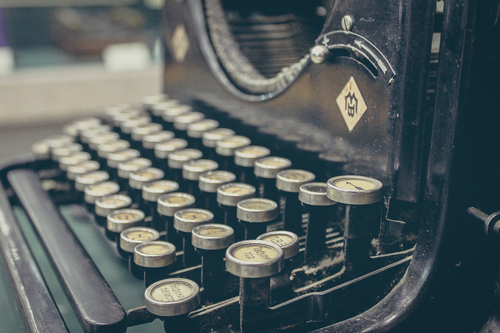Jessica Lidh's Blog, page 2
September 3, 2014
My Wall of Women: A Collection of Lives Well-lived

I collect women. Well, that’s not exactly true. I collect pictures of women. It all started in a rundown antique mall in a rundown town somewhere in the mountains on the Tennessee-North Carolina state line. That’s where I collected my first group of girls.
They’re trapped beneath glass, divided between two frames, and close to a century old. I found them buried beneath the standard pile of antiquated merchandise—fraying quilts, faded tablecloths, tarnished copperware. They were stunning. Draped in belted, sheer dresses and sporting closely-cropped tresses resembling Clara Bow or Carole Lombard, the girls are suspended in time, in an eternal woodland dance. Their lines are beautiful, their movement graceful, their expressions serene. I bought them for $20 a piece.
After I discovered the girls, scouting for women became my thing. When rummaging through yard sales or estate sales, antique shops or Good Will, I was on the hunt for women. But I didn’t want just any women. I wanted women who embodied something bigger than themselves. I couldn’t really describe to my husband what it was that drew me to certain photographs and not others. Some x-factor? Some secret formula? I only knew the women I collected needed to be different.
First of all, they needed to be old. I don’t have any woman in color. All my photos are black and white. Secondly, they needed to be original photographs. No prints. No copies. I wanted the real thing. And thirdly, my women needed to be breaking some unspoken code of ethics. They needed to somehow prove to the camera that they were more than their societal labels. They needed to show me they had courage.
Here’s the thing. When I imagine the women of history—those who have come before me—I can’t help but think of the pressures, the constraints, the rules for which they had to abide. I envision girdles, and aprons, and typewriters. I see them trapped inside invisible boxes of which they wanted desperately to escape. But maybe that’s not fair of me. Maybe what I imagine is an incomplete picture.
Because the women in my photos? They’re not any of those things. The photographs I collect remind me—and I think this is why I love them so—that women have always been rule-breakers, they’ve always been adventure-seekers, they’ve always been brave. My women—whether riding alligator bareback, hiding a smile behind a tuft of cotton candy, or dancing hand-in-hand among wildflowers—epitomize everything I want for me and for my daughter: to be daring, to be beautiful, to be free.
September 2, 2014
6 Writing Hacks for When You're Struggling to Create

I have a confession to make. I find the creative process exhausting. So exhausting, in fact, that I often take advantage of a few writing hacks to keep my life easier and my fingers typing. These hacks serve as reminders that I don't have to reinvent the wheel when it comes to inventing my fictional narratives. I’m happy to pass them along so that you, too, may find ideas where you least expect them.
Always remember to write about the day something different happened. This is my number one rule to writing. No one wants to read about a day in the life of ordinary existence; we want to read about the day your character woke up and found out that something about his life (or his world) had changed. One of my favorite short stories I ever wrote was about the time a woman went to purchase her favorite lipstick only to find it had been discontinued. The result was a complete psychotic break for my protagonist who then underwent a serious identity crisis. All because her routine had changed. Something different happened.Steal character traits from people you already know. Our lives are literally filled with interesting casts of characters; why not take advantage of their flaws, their temperaments, their strengths and weaknesses? And you don't have to steal the complete bundle. Instead, I piecemeal character traits from lots of different people I know to create a new, well-rounded character. In my first novel, the two male love interests are based on men I've known in my life. One of the characters is a combination of some of my exes' best qualities while the other is more of a literal representation of a friend I had in high school. When it comes to creating unique characters, I never have to look too far for inspiration. Steal settings of places you've been. Like the former hack, utilize the locations in your daily life. Why invent new settings when you can easily pull from places you intimately know? I once needed a grocery backdrop, so instead of making one up, I described in detail a market at which I often shop (I just called it a different name, added a meat counter, and doubled its size). Unless you're writing fantasy or sci-fi, you don't have to create new space if what you need already exists. (And even for fantasy and sci-fi, I'd argue you can still pull inspiration for your other-worlds from the one you live in now.)Paint a picture from a picture. Sometimes I imagine my characters looking like people I know, or I imagine them looking like the celebrities who would play them in the film version of my novel. So when I go to write their physical features, I pull up a photograph of that person (famous or not) and I describe what I see. I take note of any unique physical characteristics (e.g., freckles, moles, scars, hair color, face shape) and I make sure to include them in the story. Those details make your characters seem real. I once envisioned a character as a certain famous English actor, so when it came time to describe his physical attributes, I combed through online pictures of him to make sure I got his features just right. And no one ever knew. Your audience never has to know your character is wearing someone else's face.Keep conflict on each page. If you find yourself in a writing rut, ask yourself, "What is my character up against on this page?" It doesn't always have to be an epic struggle (and it shouldn't be), but on each page he should face some kind of conflict, big or small. I find my manuscript gets the most stale (and slow and boring) when I lose sight of all the things keeping my character from reaching his goal. When in doubt, introduce more conflict. Things can never get too dire for your character. Conflict makes for compelling stories. And the greater the conflict, the greater the achievement (or the tragedy) at the end.When you come to a dead end in your writing and you literally have no creative juices flowing, take a walk. I've always found a bout of exercise and fresh air help me in sorting out my ideas or introducing new ones. Need a new character? Go to your local coffee shop or mall or airport and find him. People watch. Eavesdrop. Take notes. Always be on the lookout for someone who will ignite that spark of an idea, that moment when you think to yourself, "What's his story?"September 1, 2014
On My Writing Process

I recently got into a conversation with a fellow writer about my writing process. It started with his simple—albeit loaded—question, “How do you write?” His tone wasn’t accusatory in the least, but something about the question caught me off-guard. It made me wonder. How do I write? l almost didn’t want to tell him. As if my writing process is like some secret family recipe I’m fearful to share with others because I’ll expose the fact that I cook with Saltine crackers. (Saltine crackers, by the way, is the hidden ingredient in my grandmother’s carrot loaf recipe, a carrot recipe superior to all others…)
I’m what’s known in the biz as a “pantser,” the opposite of the “plotter.” I’m jealous of the plotters, those writers fortunate enough to have the foresight where their novels are heading and how they will end. Not me. I’m a pantser; I write by the seat of my pants. It’s a blessing and a curse. My characters and my story are unscripted, so they evolve as I go, but some days I sit in front of my computer and find myself running on empty. My creative outlet is dried up and I cannot for the life of me find anything interesting to happen to my characters. Those days are hard, and I lament the fact that I don’t/can’t/won’t convert to the plotters’ camp.
I also approach each writing session as if I’m trying to seduce the words out me. My friend laughed when I told him I play music and light a candle—the scent? Orange marmalade, a scent that conjures smells of cloves and fallen leaves and honey. Depending on the day, depending on the story, depending on where I am in the conflict, I choose my music carefully. Right now, I’m writing almost exclusively to a bluegrass station on Pandora (“Appalachia Waltz,” to be exact) because the majority of my manuscript takes place in the mountains of West Virginia. With my first novel, The Number 7, I wrote to a lot of Django Rhinehardt and Edith Piaf. My other idiosyncrasies? I can’t write by hand. I’m usually only creative in the morning. And I start each session with a cup of black coffee.
I know I’m not the only author who demands certain writing conditions. Capote wrote lying down. Kerouac wrote from midnight till dawn. Angelou kept a hotel room and paid for it by the month. Nabokov wrote on index cards. Rowling outlines. Dan Brown hangs upside down. All this goes to show we writers may be a finicky bunch, but we cannot let our demands prevent us from the hard part, the writing. As E.B. White warns us, and which I agree with whole-heartedly, “A writer who waits for ideal conditions under which to work will die without putting a word to paper.”



